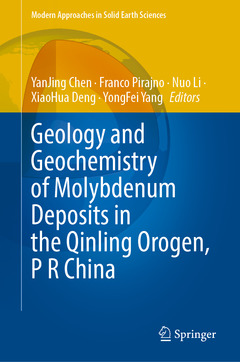Description
Geology and Geochemistry of Molybdenum Deposits in the Qinling Orogen, P R China, 1st ed. 2022
Modern Approaches in Solid Earth Sciences Series, Vol. 22
Coordinators: Chen YanJing, Pirajno Franco, Li Nuo, Deng XiaoHua, Yang YongFei
Language: English
Support: Print on demand
Description
/li>Contents
/li>Biography
/li>Comment
/li>
This book is the first systematic treatise of available data and view-points obtained from geological and geochemical studies of the Mo deposits in Qinling Orogen, China. Qinling Orogen has a minimum reserve of 8.7 Mt Mo, ranking the largest molybdenum province both in China and the world. Incorporating all known Mo deposit types in the world, it presents extensive studies of Mo deposits of world-class and unusual types within tectonic settings. The Qinling Orogen was finally formed during continental collision between Yangtze and North China cratons, following the Triassic closure of the northernmost paleo-Tethys. It hosts 49 Mo deposits formed in seven mineralization events since 1850 Ma, with all the world-class deposits being formed during 160-105 Ma, coeval with collisional orogeny. These deposits are assigned to magmatic and metamorphic hydrothermal classes. The magmatic hydrothermal class includes porphyries, skarns, and intrusion-related veins (carbonatite, fluorite and quartz). The porphyry Mo systems in Qinling Orogen are predominated by Dabie-type formed in continental collision setting, followed by Endako- and Climax-types formed in continental arcs and rifts, respectively. The metamorphic hydrothermal Mo deposits are only reported in Qinling Orogen, and thus a new crustal continuum model for the orogenic class mineral systems is proposed. A scientific linkage between ore geology and fluid inclusions is introduced and verified both by theory and case studies. This is the first research book comprehensively displaying continental collision metallogeny. This literature will benefit both Western and Chinese mineral explorers and miners, as well as research scientists and students.
Prof. YanJing Chen, has a Ph.D. in Nanjing University. He is a Professor at School of Earth and Space Sciences, Peking University, and adjunct professor at Shandong University of Science and Technology. He is an Associate Editor of Ore Geology Reviews and Geological Reviews, and on the Editorial Board of more than ten journals such as Minerals. Research fields include economic geology, geochemistry, and geological and environmental events (GOE) and their associated mineralization. He has won the National Natural Science Award (2015) for the study of continental collision metallogeny.
Prof. Franco Pirajno, has a Doctoral degree in Geological Sciences from the Vesuvius Volcano Observatory, University Federico II. He has considerable experience in tectonics, ore deposit geology and mineral exploration in the world. He is Adjunct Professor at The University of Western Australia, Institute of Mineral Resources at CAGS, Visiting Professor at Peking University, HonoraryResearch Fellow at CECAMS Natural History Museum, London. He is the single author of 4 books. He is appointed Editor-in-Chief of Ore Geology Reviews and Series Editor of Solid Earth Sciences (Springer) in 2012.
Dr Nuo Li, got Ph.D. from Peking University, is a Professor at the Research Center for Mineral Resources, Xinjiang Institute of Ecology and Geography, CAS. She has considerable experience in mineral systems of porphyry, epithermal and orogenic types, as well as the natural or synthetic fluid/melt inclusions. She has been an experienced researcher at the Institute of Mineralogy, Leibniz University Hannover, granted by the Alexander von Humboldt Foundation. She is a winner of Hou Defeng Award, granted by the Society of Mineralogy, Petrology and Geochemistry of China (2020).
Dr XiaoHua Deng, got Ph.D. from Peking University, is a Research Professor and Deputy Director of the Department of Exploration Targeting, Beijing Institute of Geology for Miner




